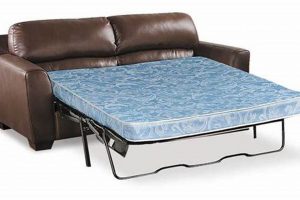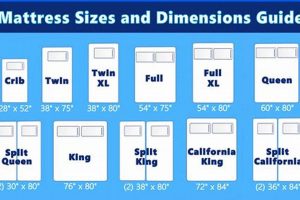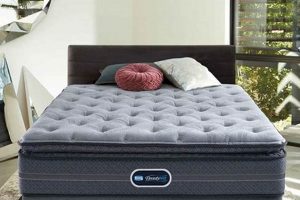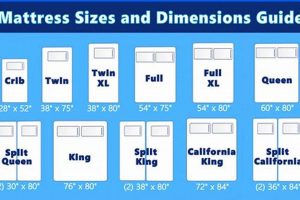A complete bed support system commonly includes a mattress and a box spring, both manufactured to standard dimensional specifications. The size designation “full” denotes a mattress width of approximately 54 inches and a length of 75 inches. This combination provides a standardized platform for sleep. The pairing is frequently offered as a matched ensemble from manufacturers, ensuring compatibility and coordinated performance.
The integration of a mattress with its corresponding box spring is integral to the lifespan and comfort of the sleeping surface. The box spring acts as a shock absorber, reducing wear on the mattress and distributing weight evenly. Historically, box springs contained active coils to provide additional support; modern versions often feature a more rigid, supportive foundation that still performs the critical function of elevation and support. This elevation facilitates airflow, minimizing moisture buildup.
Subsequent sections will address the components separately, examining the construction materials, design variations, and the factors influencing the purchase decision. The selection criteria encompass firmness levels, support technologies, and the considerations relevant to differing sleep styles and individual requirements.
Considerations for Acquisition
This section presents guidelines for selecting the correct sleep system. The process requires careful evaluation of individual needs and preferences.
Tip 1: Assess Support Requirements: Firmness levels should align with body weight and sleeping posture. Heavier individuals and stomach sleepers often benefit from firmer mattresses, while lighter individuals and side sleepers may prefer softer surfaces. A mismatch can induce discomfort or spinal misalignment.
Tip 2: Evaluate Box Spring Construction: The box spring must be structurally sound and provide uniform support. Inspect the frame for sturdiness and examine the covering for durability. Inferior construction can compromise the mattress lifespan.
Tip 3: Investigate Mattress Materials: Internal components influence temperature regulation, motion isolation, and overall comfort. Memory foam, latex, and innerspring mattresses offer distinct advantages; research is crucial. Specific materials may be better suited to certain sleep styles.
Tip 4: Determine Size Appropriateness: While this bed size is adequate for single sleepers, couples may find it constricting. Consider available space and occupancy when determining size suitability. Larger dimensions contribute to undisturbed sleep.
Tip 5: Verify Warranty Provisions: Mattress and box spring warranties protect against manufacturing defects. Thoroughly review the terms and conditions prior to purchase. Note any exclusions or limitations on coverage.
Tip 6: Consider Foundation Height: The combined height of the mattress and box spring should allow for easy ingress and egress from the bed. Insufficient or excessive height can pose mobility challenges. This factor is particularly relevant for individuals with physical limitations.
Prioritizing these considerations will ensure the acquisition of a sleep surface that promotes restorative rest and long-term satisfaction. A well-chosen system contributes to improved sleep quality and overall well-being.
The subsequent section will address the maintenance and care protocols necessary to maximize the longevity of these items.
1. Standard Dimensions
The term “full size,” when applied to a mattress set with a box spring, refers to specific, regulated dimensional standards. A failure to adhere to these standards would render a mattress incompatible with its intended support structure and bedding accessories. Specifically, a full-size mattress measures approximately 54 inches in width and 75 inches in length. The box spring, designed to provide foundational support, must correspondingly adhere to these dimensions. Deviations from these measurements, even slight ones, can compromise stability, comfort, and the overall structural integrity of the bed. An example of a practical issue stemming from dimension mismatches is premature wear and tear on the mattress due to inadequate or uneven support.
The importance of standardized dimensions extends beyond mere physical compatibility. Accurate dimensions are crucial for selecting appropriately sized sheets, blankets, and bed frames. Non-standard dimensions introduce compatibility issues, requiring custom-made or ill-fitting bedding, leading to additional expense and inconvenience. Manufacturers adhere to these standards to ensure interoperability across various brands and product lines. Consider, for instance, the frustration of purchasing a fitted sheet only to discover it is too small or too large for the mattress due to dimensional inconsistencies.
In summation, the concept of “standard dimensions” is not merely descriptive; it is a fundamental requirement for the proper functioning and usability of this type of mattress and box spring set. Adherence to these standards ensures compatibility, comfort, and longevity. A lack of adherence introduces practical difficulties and economic burdens. Consequently, both manufacturers and consumers must prioritize dimensional accuracy to realize the full benefits of these sleep systems.
2. Support Structure
The support structure of a full-size mattress set, principally embodied by the box spring, directly influences the performance and longevity of the sleep surface. The box spring acts as a foundational element, distributing weight and absorbing impact, thereby mitigating stress on the mattress itself. Without adequate support, a mattress is prone to premature sagging, uneven wear, and a reduction in overall comfort. For example, a low-quality box spring, lacking sufficient internal reinforcement, may exhibit localized compression, leading to corresponding depressions in the mattress and a compromised sleeping experience. The impact of the support structure on spinal alignment cannot be overstated; insufficient or uneven support can contribute to back pain and discomfort.
Modern box spring designs incorporate varied construction techniques and materials. Traditional coil-based systems offer a degree of springiness, while newer models employ solid or semi-flex foundations. The selection of a particular type of support structure should align with the design characteristics of the mattress. For instance, a memory foam mattress, which contours to the body, often benefits from a firm, non-yielding foundation to prevent excessive sinking. In contrast, an innerspring mattress may pair well with a coil-based box spring to provide enhanced bounce and responsiveness. The practical application of this understanding lies in the informed selection of a matched set, optimized for individual sleeping preferences and physical needs.
In summary, the support structure is not merely an accessory but an integral component of a complete sleep system. It is the primary determinant of mattress longevity, comfort, and the maintenance of proper spinal alignment. Challenges arise when mismatched components are combined, leading to suboptimal performance and premature wear. A comprehensive understanding of the relationship between the mattress and its supporting structure is crucial for maximizing the value and benefits derived from the full-size mattress set.
3. Material Composition
The constituent materials of a full-size mattress set, encompassing both the mattress and its accompanying box spring, exert a substantial influence on the overall comfort, durability, and hygienic properties of the ensemble. Material choices dictate factors such as breathability, support level, and resistance to allergens and dust mites. For instance, a mattress incorporating memory foam, known for its conforming properties, contrasts sharply with an innerspring model, which relies on a network of coils for support. The box spring, typically constructed from wood and fabric, contributes to the set’s structural integrity and can impact airflow. The selection of specific materials has a direct causal relationship with the end-user’s sleeping experience. Examples include latex, prized for its resilience and hypoallergenic qualities, or polyurethane foam, often employed for its cost-effectiveness, each with implications for the overall feel and suitability of the sleep surface.
The practical application of understanding material composition lies in making informed purchase decisions aligned with individual needs and preferences. For individuals prone to allergies, a mattress and box spring encased in hypoallergenic fabrics and utilizing materials resistant to dust mite infestation become paramount. Similarly, those prioritizing temperature regulation may opt for mattresses incorporating breathable materials such as open-cell foam or natural fibers. The box spring’s construction, frequently overlooked, also warrants attention. A robust wooden frame and tightly woven fabric covering contribute to the set’s longevity and prevent sagging, thereby maintaining consistent support over time. Consider the differential impact: A set comprised of high-density foam and a reinforced box spring is apt to outperform one constructed from lower-quality materials, exhibiting superior resistance to compression and wear.
In summary, material composition is a pivotal determinant of a full-size mattress set’s performance characteristics. Informed selection, guided by an awareness of material properties and individual needs, is crucial for maximizing comfort, durability, and hygienic benefits. Neglecting this aspect can lead to dissatisfaction, premature wear, or the exacerbation of existing health conditions. Ultimately, a discerning approach to material composition translates to a better sleep experience and a more cost-effective investment in long-term well-being. Future consideration should be given to sustainably sourced and recyclable materials to mitigate environmental impact.
4. Firmness Options
Firmness options, in the context of a full-size mattress set with box spring, represent a critical determinant of sleep quality and musculoskeletal health. The firmness level dictates the degree of support offered to the sleeper’s body, influencing spinal alignment and pressure distribution. A mismatch between firmness and individual physiological needs can precipitate discomfort, pain, or even exacerbate pre-existing conditions. For instance, a side sleeper may experience shoulder or hip pain on an excessively firm mattress due to concentrated pressure points, whereas a stomach sleeper might find insufficient support on a too-soft mattress, leading to spinal misalignment. Therefore, the availability of varied firmness options is not merely a matter of consumer choice, but a necessary consideration for ensuring ergonomic compatibility.
The practical significance of understanding firmness options extends to the mitigation of sleep-related disorders and the enhancement of restorative rest. Manufacturers typically categorize firmness levels on a spectrum, ranging from “extra soft” to “extra firm,” with gradations in between. The selection process should involve a careful assessment of body weight, sleeping posture, and any existing musculoskeletal issues. For example, individuals with lower back pain often benefit from medium-firm mattresses that provide adequate lumbar support, while lighter individuals may prefer softer surfaces that conform more readily to their body contours. Failure to consider these factors can result in compromised sleep quality, diminished daytime function, and potentially, long-term health consequences. Moreover, the box spring plays a role, indirectly, as its construction either complements or detracts from the perceived firmness of the mattress.
In summation, firmness options represent a fundamental component of a full-size mattress set, directly influencing comfort, spinal alignment, and overall well-being. The informed selection of an appropriate firmness level, based on individual needs and preferences, is paramount for optimizing sleep quality and minimizing the risk of musculoskeletal discomfort. Challenges remain in standardizing firmness scales across manufacturers, underscoring the importance of direct evaluation and consultation with healthcare professionals when necessary. Understanding firmness options is not merely about selecting a preference, but about investing in long-term health and restorative sleep.
5. Cost Considerations
The economic dimension of acquiring a full-size mattress set with box spring necessitates a careful evaluation of multiple factors. The initial purchase price represents only a fraction of the total cost of ownership, which encompasses considerations of durability, lifespan, and potential ancillary expenses. Effective cost management requires a holistic perspective, balancing upfront investment with long-term value.
- Initial Purchase Price
The most immediate cost is the retail price of the mattress set. This figure varies significantly based on brand reputation, materials used, and construction quality. Discount retailers, online vendors, and brick-and-mortar stores offer a spectrum of price points. Opting for the lowest price may compromise durability and comfort, leading to earlier replacement and, consequently, higher long-term costs. Conversely, premium-priced sets may offer superior support and longevity, warranting the initial investment.
- Expected Lifespan and Replacement Costs
The lifespan of a full-size mattress set directly correlates to its overall cost-effectiveness. Low-quality sets may exhibit sagging, loss of support, or material degradation within a few years, necessitating premature replacement. Conversely, higher-quality sets, with proper maintenance, can maintain their integrity for seven to ten years or more. The projected replacement cost must be factored into the total cost of ownership, influencing the initial purchase decision.
- Ancillary Costs: Bedding and Accessories
The acquisition of a mattress set often necessitates additional expenditures on bedding and accessories. Fitted sheets, mattress protectors, and appropriate bed frames are essential for hygiene and support. These ancillary costs can accumulate significantly, particularly when opting for premium materials or specialized sizes. Budgeting for these associated expenses is crucial for accurate cost estimation.
- Warranty Coverage and Potential Repair Costs
Mattress sets typically come with manufacturer warranties covering defects in materials and workmanship. Understanding the terms and conditions of the warranty is essential. While a comprehensive warranty can mitigate potential repair or replacement costs, it is crucial to recognize that warranties often exclude coverage for normal wear and tear. Assessing the manufacturer’s reputation for honoring warranty claims is also a relevant cost consideration.
Integrating these facets into a comprehensive cost analysis enables a discerning purchaser to make an informed decision regarding a full-size mattress set with box spring. By considering the interplay of initial investment, lifespan, ancillary expenses, and warranty coverage, one can optimize value and minimize the long-term financial burden. For instance, a moderately priced set with a robust warranty and a projected lifespan of seven years may prove more economical than a cheaper alternative requiring replacement within three years.
Frequently Asked Questions Regarding Full Size Mattress Sets with Box Spring
This section addresses common inquiries and clarifies prevalent misconceptions surrounding full-size mattress sets with box springs. The information presented aims to provide a comprehensive understanding of these products, aiding in informed purchasing decisions.
Question 1: What are the standard dimensions associated with this product?
A full-size mattress, as part of a complete set, adheres to dimensions of approximately 54 inches in width and 75 inches in length. The accompanying box spring is manufactured to correspond precisely with these measurements, ensuring proper support and fit.
Question 2: Does a new mattress require a new box spring?
While not always mandatory, replacing the box spring concurrently with the mattress is generally advisable. An aging or compromised box spring can negatively impact the support and lifespan of a new mattress. A mismatched or worn box spring may invalidate manufacturer warranty provisions.
Question 3: What factors determine the appropriate firmness level?
Selection of mattress firmness should align with individual sleeping posture, body weight, and any existing musculoskeletal conditions. Side sleepers often benefit from softer surfaces, while stomach sleepers may require firmer support to maintain spinal alignment. Body weight is a significant factor. Consultation with a healthcare professional may be beneficial in certain cases.
Question 4: How does the material composition affect the overall performance?
The materials used in both the mattress and box spring influence comfort, durability, and breathability. Memory foam, latex, and innerspring construction offer distinct performance characteristics. Breathable fabrics promote airflow, mitigating moisture accumulation and temperature dysregulation.
Question 5: What is the expected lifespan?
The typical lifespan of a full-size mattress set with box spring ranges from seven to ten years, contingent upon quality, usage patterns, and maintenance practices. Premature sagging, loss of support, or visible degradation indicate the need for replacement. Adherence to recommended care protocols can extend the usable life.
Question 6: Are there specific maintenance requirements?
Regular rotation of the mattress is recommended to promote even wear. Periodic vacuuming can minimize dust accumulation. Protecting the mattress with a waterproof cover guards against spills and stains. Proper support from the bed frame is crucial. Consult manufacturer guidelines for specific care instructions.
The answers provided offer fundamental guidance regarding full-size mattress sets with box springs. A well-informed purchaser is empowered to make decisions aligned with their unique requirements and budgetary considerations.
The subsequent section will delve into the realm of product comparisons, contrasting various brands and models within the category.
Full Size Mattress Set with Boxspring
This exploration has comprehensively examined the constituent elements, purchase considerations, and maintenance requirements associated with the full size mattress set with boxspring. Key aspects, including dimensional standards, support structure, material composition, firmness options, and cost implications, were thoroughly analyzed. The information provided facilitates a well-informed acquisition process, promoting long-term satisfaction and maximizing value.
The selection of a full size mattress set with boxspring represents a significant investment in personal well-being. A discerning approach, guided by the principles outlined herein, is crucial for ensuring optimal sleep quality and minimizing potential discomfort. Continued advancements in materials science and ergonomic design promise to further enhance the performance and longevity of these sleep systems. Prioritizing informed decision-making remains paramount.







